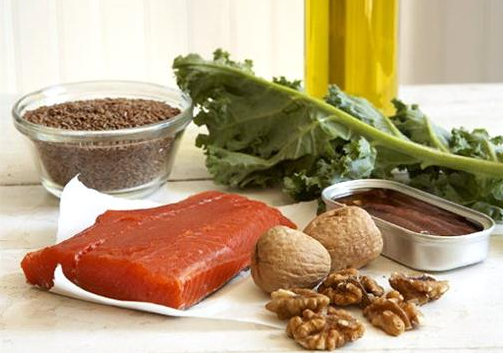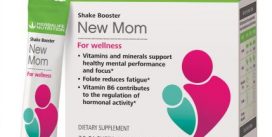All about Omega-3 and the Healthiest Foods in the World

The Importance of Omega-3 Fatty Acids
Taking omega-3 fatty acids appeared to lower inflammation and guard against further declines in heart function among recent heart attack survivors already receiving optimal standard care, according to results from a randomized, controlled trial to be presented at the American College of Cardiology’s 64th Annual Scientific Session in San Diego.
 Patients in the study taking 4 grams of prescription-only omega-3 fatty acid capsules daily for six months after a heart attack were significantly more likely to show improvements in heart function compared to patients taking a placebo. Heart function was measured by an expansion of the left ventricular endsystolic volume index. Patients taking omega-3 fatty acids also had significantly less evidence of fibrosis — a thickening or scarring of the areas of the heart remote from the heart attack, which can develop when the surviving heart muscle works harder and under high pressure to compensate for the damage to the heart. The data suggests that patients who were able to mount a substantial change in levels of omega-3 fatty acids in their blood derived the most benefit.
Patients in the study taking 4 grams of prescription-only omega-3 fatty acid capsules daily for six months after a heart attack were significantly more likely to show improvements in heart function compared to patients taking a placebo. Heart function was measured by an expansion of the left ventricular endsystolic volume index. Patients taking omega-3 fatty acids also had significantly less evidence of fibrosis — a thickening or scarring of the areas of the heart remote from the heart attack, which can develop when the surviving heart muscle works harder and under high pressure to compensate for the damage to the heart. The data suggests that patients who were able to mount a substantial change in levels of omega-3 fatty acids in their blood derived the most benefit.
“Giving a high dose of omega-3 fatty acids soon after a heart attack appears to improve cardiac structure and heart functioning above and beyond the standard of care,” said Raymond W. Kwong, M.D., M.P.H, director of cardiac magnetic resonance imaging at Brigham and Women’s Hospital in Boston and the study’s senior author. “Because this is a unique group of patients with remarkably high adherence to [guideline-directed] treatments for acute myocardial infarction already, we feel fairly confident that the benefits from this therapy are additive. The implications of this study could be fairly large.”
An estimated 720,000 Americans have heart attacks each year. After a heart attack, the heart can remodel or reorganize itself to maintain or improve function. In some cases, the heart may undergo adverse changes such as enlargement of the heart, decreased pumping ability or added cardiac strain that can predispose someone to heart failure and arrhythmias later in life.
Watch this video about omega-3 with Nobel Price Winner Ph.D Louis Ignarro:
Although earlier studies have shown that omega-3 fatty acids may lower the risk of irregular heartbeats and death from a heart attack, research has not consistently shown a benefit. Kwong said his research is the first to use quantitative cardiac imaging to look at how omega-3 fatty acids might actually protect the heart after a major heart attack.
Patients taking the omega-3 fatty acids were 39 percent less likely to show a deterioration of heart function as compared to patients taking a placebo. The analysis also looked at key markers of systemic inflammation, which were also more likely to be improved in those taking the fish oil. In particular, the percent reduction in ST2, a marker of the severity of adverse cardiac remodeling and tissue fibrosis, was substantially greater in the treatment arm after six months.
For many years, the American College of Cardiology and the American Heart Association have recommended that people eat fish rich in omega-3 fatty acids at least twice a week because of its potential heart benefits.
Kwong said most North Americans do not follow this advice, while Japanese populations with higher levels of omega-3 and an otherwise similar risk profile to North Americans have lower risks of heart disease and sudden cardiac death. The increase in the omega-3 blood content of many patients in Kwong’s study at six months was similar to levels found in Japanese populations with a diet very rich in omega-3 fatty acids.
Fatty fish such as salmon, tuna, trout and sardines contain the most omega-3 fatty acids. Fatty acids are a key component of cell membranes and they help with cell signaling, proper immune function and may also improve cognitive functioning. This study is limited in that it did not investigate the association between omega-3 fatty acids and cardiac events after heart attack; assessing this relationship would require a large group of patients over many years. It also did not evaluate this treatment immediately after having a heart attack.
Some omega-3s are simpler than others. The simplest is called alpha-linolenic acid, or ALA. Like most vitamins, ALA is especially important in our diet because our bodies cannot make it from scratch. Either we consume it, or we don’t have enough. Fortunately for us, many commonly eaten plant and animal foods contain ALA.
For other omega-3s, this all-or-nothing scenario is not the case. Under the right circumstances, our bodies can usually take ALA and transform it into other omega-3s. These other omega-3s are more complicated than ALA and contain more double bonds. The best studied are EPA (eicosapentaenoic acid) and DHA (docosahexaenoic acid). EPA has five double bonds and DHA has six. In a large number of research studies, there are clear health benefits provided by EPA and DHA that are not provided by ALA. These health benefits involve support of many body systems and decreased risk of many chronic diseases.
So without question, our bodies need ALA, EPA, and DHA to stay healthy, and we need to consume ALA-containing foods no matter what because our bodies lack the ability to make ALA. But what about EPA and DHA? Are we absolutely required to eat foods containing EPA and DHA?
The answer to that question is particularly important since it can affect our entire approach to eating. If we only need to eat ALA-containing foods—and can trust our bodies to make all of the EPA and DHA that we need—we become free to choose whatever type of diet we would like, including a strict vegan diet that contains no animal foods whatsoever (including no milk, no cheese, and no eggs). That’s because a wide variety of plant foods contain small-to-moderate amounts of ALA. However, if we need to obtain EPA and DHA directly from food, we become much more restricted in our food choices. For example, if we are trying to implement a strict vegan diet with no animal foods whatsoever and want to obtain DHA from our diet, our choices would most likely be limited to sea plants (which can contain DHA) or some fermented foods (like fermented soy foods) which had been allowed to ferment with the help of specific fungi that were capable of producing DHA. The absence of DHA in land plants is the reason for these very limited options.
Excellent sources of alpha-linolenic acid (ALA) include flaxseeds and walnuts. Very good sources of ALA include sardines and salmon, as well as cauliflower, Brussels sprouts, and mustard seeds. Good sources include a wide variety of vegetables (collard and turnip greens, spinach, kale, green beans, romaine lettuce, summer squash, and winter squash), fish (scallops, shrimp, and cod), legumes and foods made from legumes (soybeans, tofu, and miso), and fruits (strawberries and, raspberries). While seafood is known for its EPA and DHA content, smaller amounts of ALA are provided by numerous seafoods. While not ranked on our Rating System Chart, animal foods including beef, dairy, and eggs may also provide varying amounts of ALA. Outside of the U.S., one study in Britain found that about 25% of ALA intake in the UK population came from fish and meat dishes, with another 8% from eggs and dairy foods. While we do not have a similar study from the U.S., we do know that the quantity of ALA in animal foods depends on the diet consumed by the animals. As a general rule, animals raised in a natural setting throughout their lives and pasture-fed on a variety of grasses, legumes, and other plants will contain more ALA in their bodies, and will therefore provide food that is richer in ALA, eicosapentaenioc acid (EPA) and docosahexaenoic acid (DHA). Seafood is the food group most concentrated in EPA and DHA.
Like all creatures, fish have an omega-3 content that is highly dependent on their diet. If they eat algae, sea plants, and other foods that are rich in omega-3s, they are able to store more omega-3s in their tissue. If they live in a habitat where omega-3s are not widely available, they store much less. The close relationship between their diet and their omega-3 content applies to all specific omega-3s found in fish, including ALA, EPA, and DHA. It also applies to all types of fish including wild-caught and farmed. Some farmed fish are fed processed omega-3 concentrates to boost their omega-3 content. Other farmed fish are fed few omega-3s and have lower-than average omega-3 content.
In the U.S., our ratio of omega-6:omega-3 fat has been estimated to fall between 20:1 and 8:1. (Those numbers mean that we eat at least eight times more omega-6 than omega-3, and perhaps as much as 20 times more.) Most studies suggest that a healthier ratio of omega-6:omega-3 lies between 4:1 and 2:1. Taken as a whole, the dietary circumstances described above leave the average U.S. adult with an insufficient intake of ALA and a compromised ability to convert ALA into other health-supportive omega-3s like EPA and DHA due to excessive intake of omega-6s.
A further problem with the average U.S. diet and omega-3s is deficient intake of nutrients required to convert ALA into EPA and DHA. This list of nutrients includes vitamins B3, B6, and C, and the minerals zinc and magnesium.
Reasons for low omega-3 intake in the U.S. diet vary, but some key reasons that apply to many meal plans are as follows:
Your best ways of increasing omega-3 nourishment are to reverse all of the above practices. Consider increasing your intake of nuts (like walnuts) or seeds (like flaxseeds). Consumption of these foods on a daily basis can work well in most meal plans. Also consider fish like salmon, sardines, shrimp, or cod on a more frequent basis. Finally, consider purchase of grass-fed and/or pastured-raised animal foods including meats, cheeses, yogurt, and eggs.
If you are following a fairly strict vegetarian or vegan diet, it may be especially difficult for you to get EPA and DHA you directly from food. (That’s because animal foods are typically richer sources of these omega-3s than plant foods.) For this reason, we recommend that you increase your intake of ALA-containing foods to a level that will provide you with approximately 4 grams of ALA per day. Here are some choices that can help you reach that 4 gram level.
Although we have partially addressed the following issue earlier in this article, we would like to emphasize one ongoing controversy that continues to hang over omega-3 research related to risk of dietary deficiency. That controversy involves metabolism of omega-3s. Researchers know that humans need all forms of omega-3s—including the forms ALA, EPA, and DHA. Researchers also know that humans can take ALA and convert it into EPA and DHA under favorable circumstances. But researchers still don’t know is exactly how often these favorable circumstances exist. Because the research jury on omega-3 metabolism is still out, we recommend taking one of two approaches to your omega-3 nourishment. A first approach is to focus on including not only ALA-rich plant foods in your meal plan, but EPA-rich and DHA-rich animal foods as well. A second approach is to focus exclusively on ALA-rich foods in your meal plan, but greatly increase your intake to the 4 gram level described earlier.
We’ve found specific omega-3 recommendations from a variety of public health organizations, including the National Academy of Sciences, American Heart Association, American Dietetic Association, World Health Organization, and National Institutes of Health. These recommendations are relatively similar, but by no means identical. We’ve provided you with more details below, but we also want to give you our own WHFoods recommendations based on the research studies that we have reviewed.
For total omega-3 fat, we recommend an average of at least 2.5 grams per day. On some days you might get slightly less, but over the course of an entire week, you’ll want to average at least this amount. Our Healthiest Way of Eating Plan averages about 3 grams of omega-3s per day, and it will give you a very practical look at what it takes to provide this amount on a meal-by-meal basis.
Read how to add more Fish to your Diet: http://blog.healthyfood.help/add-more-fish-to-your-diet/
Do you need more omega 3? Click and buy Herbalifeline now
Herbalife Online Store: http://buy-herbal-online.healthyfood.help/
__________________________
Independent Herbalife Member - Healthy FooD Nutrition Blog
Buy Authentic Herbalife Products Online :
*Fast Shipping directly from Herbalife Plant
*Freshest Herbalife Products Guaranteed
*Full Service
>>Click here and Get The Best Quality and Service Available 
Feel free to contact me! Fill the form below


